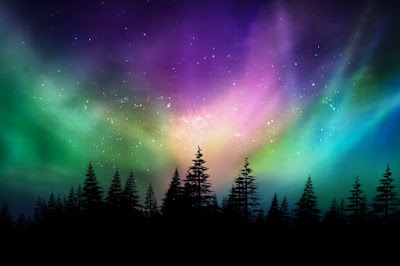Solar Storm Sparks Northern Lights Spectacle:
Friday Night Auroras Await
Dazzling displays of
auroras are set to illuminate the skies of northern states once again on Friday
night, thanks to the ongoing geomagnetic storm activity. The Space Weather
Prediction Center, a division of NOAA, reported that the solar storm activity
reached its peak on Thursday night into the early hours of Friday morning.
While the intensity of
the activity is gradually diminishing, Lt. Bryan Brasher, a project manager
with the Center, emphasized that the potential for auroras persists. "We
are still forecasting continued storming for this evening, with a possibility
of aurora becoming visible over the far Northern Tier states," he stated
on Friday.
Even as the situation
calms, the rebounding magnetosphere could still be impacted by multiple coronal
mass ejections (CMEs). CMEs are explosive releases of plasma and magnetic
material from the sun that can affect Earth's navigation, communication, and
radio signals. Additionally, they create currents in Earth's magnetic fields,
sending particles to the North and South Poles, where they interact with oxygen
and nitrogen, resulting in the mesmerizing auroras we witness.
NOAA confirmed a
robust solar storm early Friday morning, classifying it as a G-3 on the
strength scale. At G-3 status, auroras can potentially be observed as far south
as Illinois and Oregon. As the storm weakens overnight Friday and into Saturday
morning, it is expected to reach G-1 status, making auroras commonly visible in
areas like Maine and Michigan's Upper Peninsula.
The forecast for
Friday night's auroras is depicted in the map below, with red areas having the
highest likelihood of witnessing the spectacle, and green areas being less
likely. The thin red line represents the view line, suggesting that even those
outside the colored areas may catch a glimpse of the northern lights if they
are along that trajectory.
However, due to the
anticipated weaker levels of solar storms on Friday night, spotting auroras may
prove more challenging. Brasher advises those hoping to witness the northern
lights to look for the red-tinted "tops" of the aurora. Utilizing a phone
camera set to "night mode" or a camera with a long exposure can
enhance the visibility of the auroras.
As with any northern
lights event, escaping city light pollution is crucial for optimal viewing.
Clear skies without cloud cover are also essential to appreciate the beauty of
the light patterns. While Friday's expected G-1 storm may not reach the
intensity of a G-5 storm, which can bring auroras as far south as Florida and
even southern Texas, the spectacle promises to captivate observers in the
designated regions.


ليست هناك تعليقات:
إرسال تعليق